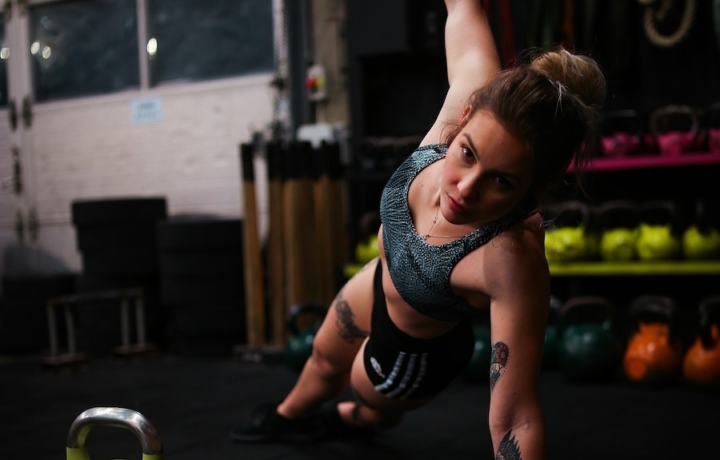Exercise
Dumbbell Russian Twist

Dumbbell Russian Twist
How to Perform
- Sit on the floor with your knees bent and feet flat, tilting your upper body back at a 45-degree angle to engage your core.
- Hold a dumbbell with both hands at chest level, keeping your arms slightly bent and positioned in front of your torso.
- Lift your feet slightly off the floor while maintaining the bent knee position, balancing on your sit bones to create an unstable base.
- Engage your core muscles by drawing your navel toward your spine and maintaining a tall, straight spine throughout the movement.
- Exhale as you rotate your torso to the right, bringing the dumbbell toward the floor beside your hip while keeping your chest lifted.
- Inhale as you return to the center position, maintaining tension in your abdominal muscles and keeping your shoulders down away from your ears.
- Exhale and rotate to the left side in a controlled manner, avoiding any momentum or jerking movements.
- Continue alternating sides at a steady pace, focusing on the rotation coming from your midsection rather than your arms or shoulders.
Important information
- Keep your back straight throughout the exercise – avoid rounding your shoulders or collapsing through your chest.
- If balance is challenging, start with feet on the floor and progress to elevated feet as core strength improves.
- Control the weight throughout the movement – faster isn't better and can reduce effectiveness while increasing injury risk.
- For beginners, start with a lighter weight or even no weight until the proper form and movement pattern are mastered.

Dumbbell Russian Twist
Exercise Details
Primary Muscles
Muscle Groups
Mechanic
Risk Areas
Built for progress
Take the guesswork out of training
Create personalized AI-powered workout plans that evolve with you. Train smarter, track every rep and keep moving forward, one workout at a time.






The Dumbbell Russian Twist stands as a cornerstone exercise for developing rotational strength in your core, specifically targeting the abs and obliques simultaneously. This intermediate movement has earned its place in various training modalities, from high-intensity interval training (HIIT) circuits to bodybuilding routines and CrossFit WODs, making it versatile for diverse fitness goals.
What sets this exercise apart is its efficiency in engaging multiple muscle groups within your core's rotational system. While your rectus abdominis (the "six-pack" muscles) work isometrically to maintain your posture, your internal and external obliques generate the power for the twisting motion. This functional movement pattern mimics the rotational forces encountered in both athletic performance and everyday activities.
The beauty of the Dumbbell Russian Twist lies in its scalability. As your core strength develops, you can progressively increase the challenge by using heavier dumbbells or extending the lever arm by holding the weight farther from your body. This adaptability makes it suitable for continuing progression even as your fitness level advances.
Beyond aesthetic benefits, this movement contributes significantly to core stability and rotational power. Athletes particularly value this exercise for its carryover to sports requiring rotational force production, like golf, tennis, baseball, and martial arts. The improved oblique strength also supports better posture and can help reduce the risk of lower back issues when performed with proper form.
For optimal results, consider integrating Dumbbell Russian Twists into your routine 2-3 times weekly, typically toward the end of your workout when your core is properly warmed up but not fatigued to the point where form might deteriorate. As with any rotational exercise, quality of movement trumps quantity, so focus on controlled, deliberate rotations rather than rushing through repetitions.
FAQ - Dumbbell Russian Twist
The Dumbbell Russian Twist primarily targets your obliques (both internal and external) while also engaging your rectus abdominis (six-pack muscles) isometrically. Secondary muscles worked include the transverse abdominis, hip flexors, and erector spinae as stabilizers.
Beginners can start with feet on the floor and a light weight or no weight at all. As you progress, elevate your feet, increase the dumbbell weight, extend your arms further from your body, or slow down the movement to increase time under tension.
The most common mistakes include rounding the lower back instead of maintaining a straight spine, moving only the arms rather than rotating from the torso, rushing through repetitions, and using momentum instead of controlled movement. Focus on initiating the twist from your core while keeping your chest up.
For muscle growth, perform 3-4 sets of 12-15 reps per leg with a full range of motion. For endurance, aim for 2-3 sets of 15-25 reps. Allow 1-2 minutes rest between sets and train calves 2-3 times weekly for best results.
This exercise can be problematic for those with existing back issues due to the rotational forces on the spine. If you have back concerns, consult with a healthcare provider first and consider alternatives like the Pallof press or dead bug exercise, which provide similar benefits with reduced spinal loading.






